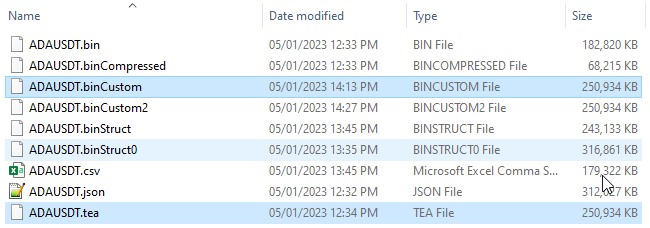I came across a situation where I have a pretty big file that I need to read binary data from.
Consequently, I realized that the default BinaryReader implementation in .NET is pretty slow. Upon looking at it with .NET Reflector I came across this:
public virtual int ReadInt32()
{
if (this.m_isMemoryStream)
{
MemoryStream stream = this.m_stream as MemoryStream;
return stream.InternalReadInt32();
}
this.FillBuffer(4);
return (((this.m_buffer[0] | (this.m_buffer[1] << 8)) | (this.m_buffer[2] << 0x10)) | (this.m_buffer[3] << 0x18));
}
Which strikes me as extremely inefficient, thinking at how computers were designed to work with 32-bit values since the 32 bit CPU was invented.
So I made my own (unsafe) FastBinaryReader class with code such as this instead:
public unsafe class FastBinaryReader :IDisposable
{
private static byte[] buffer = new byte[50];
//private Stream baseStream;
public Stream BaseStream { get; private set; }
public FastBinaryReader(Stream input)
{
BaseStream = input;
}
public int ReadInt32()
{
BaseStream.Read(buffer, 0, 4);
fixed (byte* numRef = &(buffer[0]))
{
return *(((int*)numRef));
}
}
...
}
Which is much faster - I managed to shave off 5-7 seconds off the time it took to read a 500 MB file, but it's still pretty slow overall (29 seconds initially and ~22 seconds now with my FastBinaryReader).
It still kind of baffles me as to why it still takes so long to read such a relatively small file. If I copy the file from one disk to another it takes only a couple of seconds, so disk throughput is not an issue.
I further inlined the ReadInt32, etc. calls, and I ended up with this code:
using (var br = new FastBinaryReader(new FileStream(cacheFilePath, FileMode.Open, FileAccess.Read, FileShare.Read, 0x10000, FileOptions.SequentialScan)))
while (br.BaseStream.Position < br.BaseStream.Length)
{
var doc = DocumentData.Deserialize(br);
docData[doc.InternalId] = doc;
}
}
public static DocumentData Deserialize(FastBinaryReader reader)
{
byte[] buffer = new byte[4 + 4 + 8 + 4 + 4 + 1 + 4];
reader.BaseStream.Read(buffer, 0, buffer.Length);
DocumentData data = new DocumentData();
fixed (byte* numRef = &(buffer[0]))
{
data.InternalId = *((int*)&(numRef[0]));
data.b = *((int*)&(numRef[4]));
data.c = *((long*)&(numRef[8]));
data.d = *((float*)&(numRef[16]));
data.e = *((float*)&(numRef[20]));
data.f = numRef[24];
data.g = *((int*)&(numRef[25]));
}
return data;
}
Any further ideas on how to make this even faster? I was thinking maybe I could use marshalling to map the entire file straight into memory on top of some custom structure, since the data is linear, fixed size and sequential.
SOLVED: I came to the conclusion that FileStream's buffering/BufferedStream are flawed. Please see the accepted answer and my own answer (with the solution) below.


